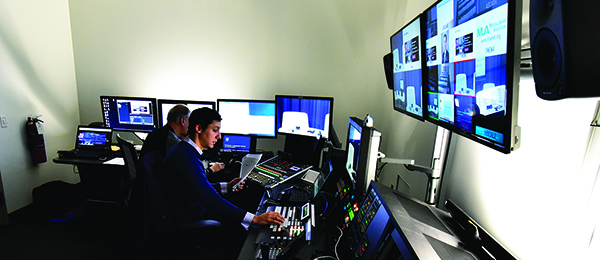
Lessons in Livestreaming Your Event
There’s good reason why more planners are turning to livestreaming their meetings and events.
For starters, there are plenty of times when potential event attendees want to attend, yet can’t make the trip because of conflicting commitments or long distances to travel.
Livestreaming also gives planners the opportunity to engage a whole new market of people who haven’t attended a past event. According to Digitell, a multimedia development company, “30 percent of people who watch a livestream of an event will attend the same event in person the following year.”
Despite the benefits, livestreaming an event has higher stakes. With larger audiences tuned in watching every move, your livestream deserves the same level of attention and planning that you give to every other part of your event.
As a venue that has hosted many successful livestreams, our technical team draws on over 25 years of experience to share five important lessons for successfully livestreaming your event.
1) Make a plan
A livestream won’t be successful if you just “wing it.” The best event livestreams account for the following:
- The audience. Who will be joining the livestream? Is it an internal audience of employees, or a whole new group of potential attendees who may not be familiar with your event? Clearly define your target audience so you can determine the best promotion strategies for getting your audience to tune in.
- The promotion strategy. Just because you livestream it, doesn’t mean remote participants will watch. Actively promote the broadcast through email, direct mail and social media. Another promotion tip: get sponsors or industry partners involved. Sponsors can help spread the word. And at the same time, having a sponsor can create an additional revenue strategy to subsidize the cost of the livestream.
- The venue. Make sure your venue is up to the livestream challenge. A venue like the OLC with a dedicated, on-site HD broadcast studio equipped with ample bandwidth and all the latest high-definition production switching, routing and editing equipment helps ensure your livestream audio and video is high quality.
2) Decide what to livestream
Many companies choose to livestream select parts of their event, keeping streamed segments to no more than 20-30 minutes max to keep attention focused. Here are several popular ways livestreaming can be used to compliment a face-to-face meeting or event:
- Have remote audiences watch and listen to your kick-off or keynote presentation.
- Stream a live demonstration or technical talk to help non-attendees see your products in action.
- Unveil a new product or share important news to a larger audience.
- Host a Q&A with company executives, or interview industry experts on hot topics and issues during a special segment.
3) Specify your technology requirements
There are many moving elements to a successful livestream – including cameras, lighting, audio and the underlying livestream technology.
Work with your tech team, plus the on-site production crew at the event venue to determine what equipment is already on hand – versus additional AV that might need to be brought in. Don’t forget to ask if equipment rental costs are additional or included in your AV.
4) Create a backup plan
Lee Balthazar, instructional systems technician at the OLC, says, “A full technical rehearsal/dry-run is crucial.” Conduct it before the event to give you and your team the chance to work out any potential kinks or issues.
Don’t forget about a backup plan too. Gregory Janowiecki, senior video expert at the OLC, says “Despite all the testing you may do, things can still go wrong. Have a plan for what you’ll do if an issue does pop-up.”
One last tip? Make a technical phone number or dedicated email address available to remote participants. This way if remote viewers experience an issue, they can easily contact a technical expert for help.
5) Give the livestream an afterlife
Once you’ve made it through the livestream, don’t let all your hard work and excellent content be for nothing. Make sure to record a copy of the livestream. Then take the footage, edit it and repurpose it for future marketing. For example, if you have another livestream coming up, include a clip of the past event in your promotions.
You’ll also want to share a copy of the livestream in its entirety shortly after the event ends. Viewers can catch up on anything they missed or re-watch their favorite parts again.
Livestreaming can be a powerful strategy for extending your event reach and attracting a larger audience. Contact the OLC to discuss the best way to add a livestream to your next meeting or event!

